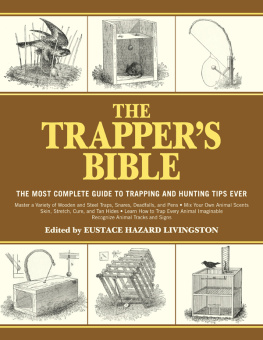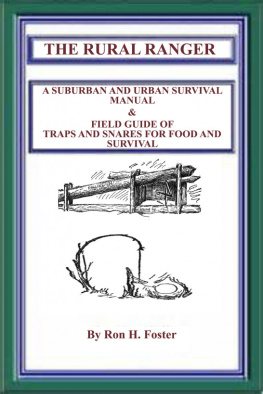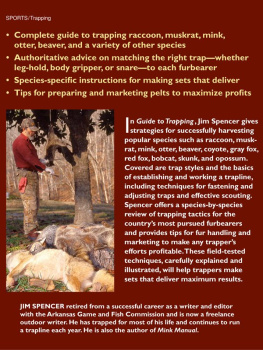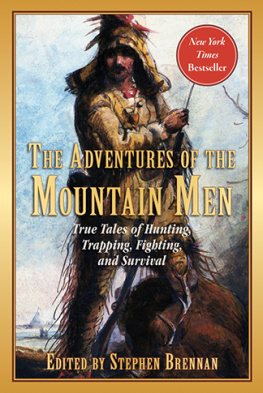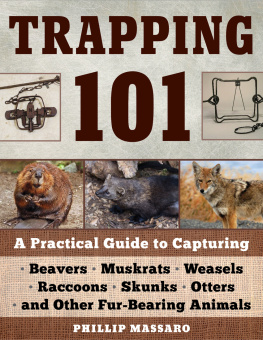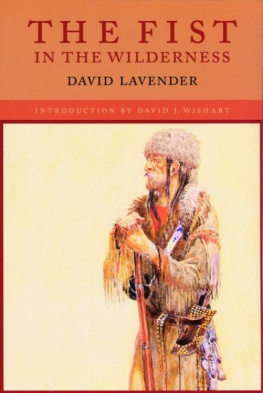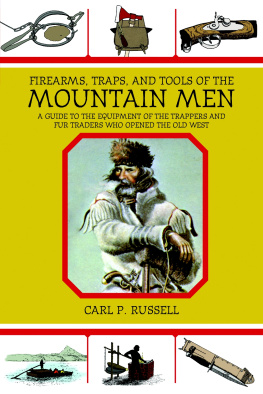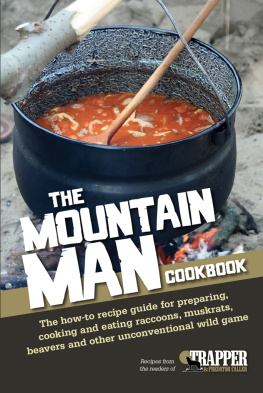
THE
TRAPPERS
BIBLE
THE
TRAPPERS
BIBLE
THE MOST COMPLETE GUIDE TO TRAPPING AND HUNTING TIPS EVER
Edited by
Eustace Hazard Livingston

Skyhorse Publishing
Copyright 2012 by Eustace Hazard Livingston
All Rights Reserved. No part of this book may be reproduced in any manner without the express written consent of the publisher, except in the case of brief excerpts in critical reviews or articles. All inquiries should be addressed to Skyhorse Publishing, 307 West 36th Street, 11th Floor, New York, NY 10018.
Skyhorse Publishing books may be purchased in bulk at special discounts for sales promotion, corporate gifts, fund-raising, or educational purposes. Special editions can also be created to specifications. For details, contact the Special Sales Department, Skyhorse Publishing, 307 West 36th Street, 11th Floor, New York, NY 10018 or .
Skyhorse and Skyhorse Publishing are registered trademarks of Skyhorse Publishing, Inc., a Delaware corporation.
Visit our website at www.skyhorsepublishing.com .
10 9 8 7 6 5 4 3 2 1
Library of Congress Cataloging-in-Publication Data is available on file.
ISBN: 978-1-61608-559-9
Printed in Canada
TABLE OF CONTENTS
Section I
BASIC TRAPPING SKILLS
Section II
THE ANIMALS
Section III
SKINNING, STRETCHING, CURING, AND TANNING
PREFACE
The book you hold before you is the collective wisdom of some of North Americas most prominent trappers, drawn from the heyday of the trade. That is to say, I have collected their writings, collated the information, and boiled down the various and sundry ingredients to render the Trappers Bible. In this mlange you may recognize the acerbic and piquant stylings of Sewell Newhouse, the mellow musings of Stanley Harding, the laconic pragmatism of Elmer Kreps, and several voluminously gassy Andersch Brothers passages. It is therefore in no way my own work, other than the manner in which the contents are selected, arranged, and redacted. With that said, I can safely say from the vantage of standing on the shoulders of those who came before me, that its crowded around here, because they appear to have all read each others books and some saw fit to borrow several passages verbatim.
Just as the ingredients of the Good Book come from over the centuries and from different authors offering different experiences and advice, which in turn seem to offer conflicting or even contradictory-seeming proscriptions about how best to do something, The Trappers Bible may also sometimes ramble on, repeat itself, and seem to contain similar internal contradictions. In such instances I would advise the reader not to give the treatment a hermeneutic analysis, but to lay it to the diversity of experience, the richness of the text, and as Ecclesiastes put it, that for everything there is a season. I leave such questions to your better judgment.
You may also note that many of the traps, ingredients, turns of phrase, and attitudes are decidedly antique. Although much of what we call the good old days were in no way good, and take for granted the liberties and conveniences of our own time, many of the tools and techniques of yesteryear are just as effective and valid now as they were thenand whats moretested by time and experience. Drawing from my own experience, I would advise that no nonstick cookware is as durable or effective as my great-grandmothers cast iron skillet, and no shave is as close or economical as my great-grandfathers straight razor. Likewise, several of the old Oneida Community traps that I bought in the year aught-and-nine still work as well as the day they came out of the tempering oven.
One old attitude I do not cotton to is ludicrous and pervasive palaver you come across in old texts about the dusky races and barbarous savages. Inasmuch as an old farmer can tell you how best to plant corn, you can safely ignore his indecent indulgences when he goes into bizarre racial hysterics beginning with Im not a racist, but... Dogs is dogs, as the saying goes, for poodles as with mutts. To maintain the utilitarian nature of the book, Ive tried to eliminate such irrelevancies, but if there is any I have overlooked, please advise me through the publisher for a subsequent edition.
Herein you will also find information about animals that at this writing are (or in the future, may be) illegal to trap, endangered, or thought to be extinct. Although there are many animals I do not think are fit to trap, if you are in the business of setting out a trap-line, theres no telling what manner of odd creature you may come across. If such is the case and you find an unusual or unexpected creature in one of your traps, the best you can do is to come forewarned. Additionally, just as no ornithological guide to North America would be complete without the Ivory-billed Woodpecker, no trappers guide could be properly considered of Cecil B. DeMille-variety Biblical Proportions without a chapter on the Catamount. Needless to say, you should check your local game laws and keep your nose clean.
Finally, I would be remiss if I didnt mention some words about conduct. The Trappers Bible contains many astute observations about the animals intrinsic natures, and how to use that knowledge to your advantage. You may come to employ innumerable duplicities, stratagems, and contrivances to lead an animal through its own natural curiosity or sense of self-interest to a place and outcome of your choosing. But there are no surer, more complete, and well-disguised deceptions as the ones we devise for ourselves to justify dubious conduct, even as we plan to conduct it. In the practice of trapping there are many opportunities for a wide latitude of needless waste, of greed, neglect, and of cruelty. If you should find yourself thoughtlessly and cheerfully flaying something you oughtnt, you may do well to consider the steps you took to arrive at that conclusion. Being a fool is simple and easily explained, but Ive never known Old Scratch to just snap people up from the ground all of a sudden with nothing more than a mushroom cloud of sulfur as a fare-thee-well. Becoming a damned fool is hard work that comes slowly in degrees, by the many screwtwists of self-justified contortion, and is nothing if not banal. Take care that you do not lose your compassion, or injure an animals dignity, or lay poison or a deadfall where they may be accessible to a child. In some cases, flaying may be too kind, whether through your own conscience, or otherwise.
EUSTACE HAZARD LIVINGSTON
JANUARY 31, 2012
NEW HAVEN, CONN.
SECTION I
Basic Trapping Skills
CHAPTER 1
Preliminaries
Among the many outdoor occupations, trapping the furbearing animals is perhaps the most pleasant and in many instances is also very profitable.
Trapping and hunting wild animals bring a man face to face with nature. He studies the woods, the running waters, and the growing things. He learns the ways of animals and birds. Even a little experience in woodcraft is valuable. The boy who has started off alone with a few traps on his back, and catches Muskrats, Mink or Skunk, is different from the boy who has never done these things. He has more self-reliance and courage, and these stand him in good stead all his life.
Although trapping was one of the earliest industries of this country, the occupation has not passed away, along with the vanishing wilderness scattered all over North America, in both the thickly settled portions and the more remote districts are thousands of trappers who each season deriving both pleasure and profit from this unique calling.
Next page
